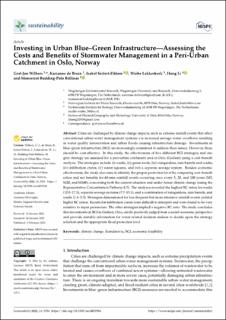| dc.contributor.author | Wilbers, Gert-Jan | |
| dc.contributor.author | de Bruin, Karianne | |
| dc.contributor.author | Seifert-Dähnn, Isabel | |
| dc.contributor.author | Lekkerkerk, Wiebe | |
| dc.contributor.author | Li, Hong | |
| dc.contributor.author | Budding-Polo Ballinas, Monserrat | |
| dc.date.accessioned | 2022-07-12T14:15:38Z | |
| dc.date.available | 2022-07-12T14:15:38Z | |
| dc.date.created | 2022-05-20T10:51:30Z | |
| dc.date.issued | 2022 | |
| dc.identifier.citation | Sustainability. 2022, 14 (3), 1934. | en_US |
| dc.identifier.issn | 2071-1050 | |
| dc.identifier.uri | https://hdl.handle.net/11250/3004703 | |
| dc.description.abstract | Cities are challenged by climate change impacts, such as extreme rainfall events that affect conventional urban water management systems via increased sewage water overflows resulting in water quality deterioration and urban floods causing infrastructure damage. Investments in blue–green infrastructure (BGI) are increasingly considered to address these issues. However, these should be cost-effective. In this study, the effectiveness of five different BGI strategies and one grey strategy are assessed for a peri-urban catchment area in Oslo (Grefsen) using a cost–benefit analysis. The strategies include (i) wadis; (ii) green roofs; (iii) raingardens, rain barrels and wadis; (iv) infiltration crates; (v) water squares, and (vi) a separate sewage system. Besides economic effectiveness, the study also aims to identify the proper protection level by comparing cost–benefit ratios and net benefits for 60-min rainfall events occurring once every 5, 20, and 100 years (M5, M20, and M100), concerning both the current situation and under future climate change (using the Representative Concentration Pathway 8.5). The analyses revealed the highest BC ratios for wadis (12.0–17.3), separate sewage systems (7.7–15.1), and a combination of raingardens, rain barrels, and wadis (1.6–2.3). Strategies dimensioned for less frequent but more intensive rainfall events yielded higher BC ratios. Results for infiltration crates were difficult to interpret and were found to be very sensitive to input parameters. The other strategies implied a negative BC ratio. The study concludes that investments in BGI in Grefsen, Oslo, can be positively judged from a social–economic perspective and provide suitable information for water-related decision makers to decide upon the strategy selection and the appropriate flood protection level. | en_US |
| dc.language.iso | eng | en_US |
| dc.publisher | MDPI | en_US |
| dc.rights | Navngivelse 4.0 Internasjonal | * |
| dc.rights.uri | http://creativecommons.org/licenses/by/4.0/deed.no | * |
| dc.title | Investing in Urban Blue–Green Infrastructure—Assessing the Costs and Benefits of Stormwater Management in a Peri-Urban Catchment in Oslo, Norway | en_US |
| dc.type | Peer reviewed | en_US |
| dc.type | Journal article | en_US |
| dc.description.version | publishedVersion | en_US |
| dc.rights.holder | © 2022 by the authors. Licensee MDPI, Basel, Switzerland | en_US |
| dc.source.pagenumber | 17 | en_US |
| dc.source.volume | 14 | en_US |
| dc.source.journal | Sustainability | en_US |
| dc.source.issue | 3 | en_US |
| dc.identifier.doi | 10.3390/su14031934 | |
| dc.identifier.cristin | 2025903 | |
| dc.relation.project | Norges forskningsråd: 270742 | en_US |
| dc.source.articlenumber | 1934 | en_US |
| cristin.ispublished | true | |
| cristin.fulltext | original | |
| cristin.qualitycode | 1 | |

